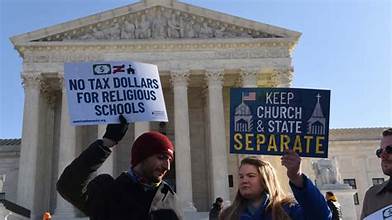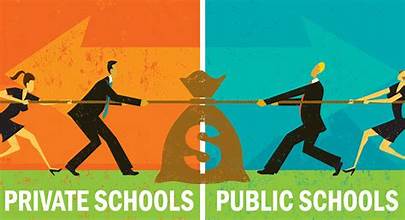The rapid expansion of state voucher programs follows court decisions that have eroded the separation between church and state.
By Laura Meckler and Michelle Boorstein
The Washington Post – Billions in taxpayer dollars are being used to pay tuition at religious schools throughout the country, as state voucher programs expand dramatically and the line separating public education and religion fades.
School vouchers can be used at almost any private school, but the vast majority of the money is being directed to religious schools, according to a Washington Post examination of the nation’s largest voucher programs.
Vouchers, government money that covers education costs for families outside the public schools, vary by state but offer up to $16,000 per student per year, and in many cases fully cover the cost of tuition at private schools. In some schools, a large share of the student body is benefiting from a voucher, meaning a significant portion of the school’s funding is coming directly from the government.
Billions of taxpayer dollars now go to religious schools

In just five states with expansive programs, more than 700,000 students benefited from vouchers this school year. (Those same states had a total of about 935,000 private school students in 2021, the most recent year for which data are available.) An additional 200,000 were subsidized in the rest of the country, according to tracking by EdChoice, a voucher advocacy group. That suggests a substantial share of about 4.7 million students attending private school nationwide are benefiting from vouchers — a number that is expected to grow.
The programs, popular with conservatives, are rapidly growing in GOP-run states, with a total of 29 states plus D.C. operating some sort of voucher system. Eight states created or expanded voucher programs last year, and this year, Alabama, Georgia, and Missouri have approved or expanded voucher-type programs. Some recently enacted plans are just starting to take effect or will be phased in over the next few years.
The growth follows a string of recent victories in the Supreme Courtand state legislatures by religious conservatives who have campaigned to tear down what once were constitutional prohibitions against spending tax money directly on religious education. It also marks a win for the school choice movement, which has spent decades campaigning to let parents use tax money for any school they see fit.
Voucher programs, which vary in their details, have grown particularly large in a half-dozen states. In each of these, participating families have overwhelmingly chosen religious schools, sometimes using the subsidy for schools their children were already attending before the programs began.
In Ohio, the GOP legislature last year significantly expanded its voucher program to make almost every student eligible for thousands of dollars to attend private school. As a result, more than 150,000 students are paying tuition with vouchers this year — up from about 61,000 in 2020. About 91 percent of this year’s voucher recipients attend religious schools, the Post analysis found.
When vouchers for students with autism and other disabilities — who typically seek specific services — are removed from the list, the portion going toward religious education rises to 98 percent. (Unless otherwise noted, the Post calculations exclude schools for students with disabilities.)
In Wisconsin, 96 percent of about 55,000 vouchers given this school year went toward religious schools, The Post found. In Indiana, 98 percent of vouchers go to religious schools. (Indiana state data only specifies the number of vouchers for schools with at least 10 recipients.)
In Florida, several programs combine to make every student in the state eligible for vouchers, with more than 400,000 participating this year. At least 82 percent of students attend religious schools, The Post found. Florida is first in the nation in both the number of enrolled students and total costof the voucher program — more than $3 billion this year.
And in Arizona, more than 75,000 students are benefiting from the Empowerment Scholarship Program, which pays for any educational expense. In 2022-2023, three-fourths of the money — about $229 million — went to 184 vendors. Most of that money went for tuition, 87 percent of it to religious schools.
Arizona also has an older voucher program, funded by tax credits, which last year subsidized tuition for at least 30,000 students. (The state tracks only the number of scholarships given, and one student can receive multiple scholarships.) Since this program was created in 1998, 19 of the 20 schools that received the most money were religious, according to a state report. Those 19 schools received about 96 percent of the $767 million spent between 1998 and 2023 at the top 20 schools.

Pennsylvania also has a large program, but state data does not show which schools families choose. Studies of states with smaller programs such as one in North Carolina and another in Illinois show that their payments, like those of larger programs, are concentrated toward religious schools.
The largest conservative state without a program — Texas — moved closer to one Tuesday when several Republicans who had opposed vouchers were defeated in legislative runoffs by pro-voucher candidates.
Supporters say these programs give parents more choices and that religious schools are receiving this money because parents see these schools as the right place for their children.
“It’s the parents’ money to use as they see is best,” said Brian Hickey, executive director of the Catholic Conference of Ohio. “We don’t necessarily see it as taxpayer money.”
To critics, the burgeoning number of taxpayer-financed religious students adds up to an unwelcome mingling of government and religion, and a drain on dollars that could support public schools, which unlike private schools are required to serve all students. That occurs both when public school students use vouchers to attend private schools — meaning their public schools lose per-pupil funding — and when the state spends large amounts of money on students whose families would otherwise pay private school tuition themselves.
A coalition of Ohio public school districts is suing the state to halt its program, charging among other things that it depletes resources meant for public schools.
“Because public funds are finite, funding EdChoice Program Vouchers … inevitably depletes the resources designated by the legislature for educating Ohio’s public-school students,” the suit alleges.
Vouchers have not led to a gutting of spending on public schools, partly because state budgets have been relatively healthy. But critics fear that cuts are coming as voucher spending rises.
In Arizona, for instance, the cost of universal vouchers has exceeded the $624 million budgeted for this year, contributing to a budget hole that lawmakers have not yet said how they will fill. That budget crunch could affect public school spending and certainly makes any increases unlikely at a time when public schools are struggling, said Beth Lewis, director of Save Our Schools Arizona, which opposes vouchers.
“Arizona schools are not able to pay for teacher pay raises or desperately needed resources. You just have teachers begging for copy paper and markers. It’s so bad,” she said. “This is robbing our local public schools and our most vulnerable students.”
The growth of vouchers
The modern voucher movement began in the early 1990s with a program in Milwaukee and spread to other states over the decades. Early programs were limited to students with disabilities, students living in big cities or families with lower incomes, sometimes in struggling public school districts, and billed as a means of giving more choices to children with particular needs. For years, in response to political and constitutional objections, lawmakers also created a roundabout voucher system that required applications to go through taxpayer-supported nonprofit corporations. Those programs, too, were targeted at students who proponents argued were being poorly served by the public schools.
Now those limits are being dropped.
Eleven states, including Ohio, Arizona, Indiana, and Florida, have programs where all or almost all children are eligible for either vouchers, which subsidize or cover tuition, or educational savings accounts, which can be spent on any school-related expense, according to tracking by EdChoice.
The fact that so much of the money is going to religious schools reflects at least in part the dominance of religious institutions among the nation’s constellation of private schools. Nationally, about 77 percent of students attending private schoolgo to religious schools, according to federal data. Butin the states with big voucher programs, the share of money going to religious schools is higher — in some cases, much higher.
Catholic schools have been among the biggest winners. Nationally, more than 1.6 million K-12 students were enrolled in Catholic schools in 2021, the latest federal data show.
In Ohio, 75,000 Catholic school students participate inthe newly expanded voucher program, said Lincoln Snyder, president of the National Catholic Educational Association. That’s about 63 percent of all Ohio students enrolled in Catholic schools.
In Florida, about 60 percent of Catholic school students tap into educational savings accounts, he said. That has benefited families that would otherwise be paying tuition themselves and also bolstered the schools, which receive money instead of having to spend funds on financial aid.
At some Ohio schools, as many as eight in 10 students attend with the help of vouchers. For instance, the boys-only St. Xavier High School in Cincinnati enrolls 1,346 students. Of them, about 1,100 receive taxpayer-funded vouchers, said Gerry Bollman, the school’s chief financial officer.
The state’s expanded voucher program “has opened the door to many families that otherwise wouldn’t have been able to send their sons here,” he said. This year’s freshman class is almost 15 percent larger than last year’s — growing from about 325 to 370 students, he said. Vouchersin Ohio — the amount depends on family income — can cover almost half of the school’s $17,350 tuition.
The recent expansion of voucher programs has turned “distant dreams into realities for hundreds of families” who attend Calvary Christian Academy’s three South Florida campuses, Calvary’s president, Jason Rachels, wrote in an email. Of the school’s 3,156 students, about 2,700 use vouchers, a Calvary spokesman wrote.
In an email, Rachels credited the program with ensuring “that an academically rich, Christ-centered education remains within reach for a diverse range of families.”
A fading church-state line
The expansion in voucher programs is part of a broader move in some states toward more government-sponsored religion inside public schools. New laws allow schools to hire chaplains for counseling or other roles, let teachers pray aloud with students and mandate hanging of “In God We Trust” signs.
In West Virginia, a new law allows teachers to discuss alternative theories to evolution. Seven states have passed measures mandating elective courses focused on the Bible, which are supposed to be secular, but critics say open the door to proselytizing.
In Oklahoma, the state Supreme Court in April considered what would be an unprecedented step toward the mingling of church and state in education, weighing whether the state could directly fund what would be the nation’s first religious charter school.
Like the growth in vouchers, those developments stem in large part from a shift in how the conservative-dominated U.S. Supreme Court, operating along largely ideological lines, has redefined religion’s role in education and public life.
For much of the 20th century, a bipartisan consensus protected a separation of church and state. But in recent decades, advocates who thought separation had gone too faradvanced the opposite argument: Limiting the rights of religious groups in schools and other government settings constitutes discrimination.
That movement got a significant boost in 2020, when the Supreme Court ruled that a Montana scholarship program that funded secular private schools had to financereligious schools as well — even though the Montana state Constitution barred it. Two years later, the Supreme Court reinforced the point in a case from Main, ruling that a program providing tuition aidto students in rural areas without public schools could not exclude religious education.
Robert C. Enlow, president of EdChoice, the advocacy group, said he used to hear state lawmakers regularly argue against vouchers by citing legal concerns, but no more.
“The majority of times now we do not hear any of `this is not constitutional,’” he said. “That’s not an argument they’re using. Not anymore.”
The Oklahoma case could mark the first time a state directly funds a religious public school. While vouchers give public money to students for private schools, allowing the Oklahoma charter school to go ahead would mean the government was paying directly for education infused with religion.
Last year, the state online charter school board approved the proposal for a new school called St. Isidore of Seville Catholic Virtual School. It is to be operated by the Roman Catholic Archdiocese of Oklahoma City and the Diocese of Tulsa, and leaders say religion will be infused throughout the curriculum.
The school is being challenged by Oklahoma’s Republican attorney general, who argued before the state Supreme Court that its creation violated the separation of church and state. Some justices expressed skepticism that a fully religious school could pass constitutional muster; others suggested there may be little difference between a religious charter school and other instances of tax dollars supporting religious entities, including private school vouchers, which have been blessed by the U.S. Supreme Court.
People on both sides of the case say it could ultimately provide the U.S. Supreme Court an opportunity to expand on its recent rulings that widened the use of tax dollars in support of religious education.
Richard Katskee, a professor who directs the Appellate Litigation Clinic at Duke University School of Law, said recent court actions represent a sweeping change in the relationship between government and religion.
“We are, as a society, underwriting religion,” he said. “That’s not what the public schools are supposed to be about.”
Emmanuel Martinez and Clara Ence Morse contributed to this report.



